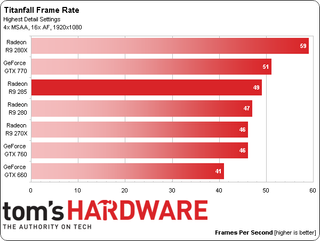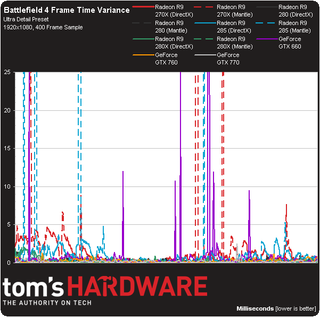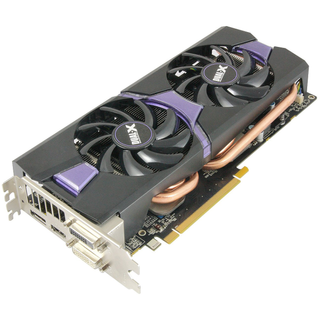AMD Radeon R9 285 Review: Tonga and GCN Update 3.0
On paper, the new Tonga-based R9 285 looks to be slightly slower than the R9 280 it is intended to replace, but there's more than meets the eye.
Why you can trust Tom's Hardware
Titanfall and Battlefield 4 Results
We'll begin our game benchmarks with Titanfall. We aren't able to test this game with FRAPS, as the only way to get consistent results is to use a private match that requires EA Origin's overlay, which is incompatible with this frame-rate measuring tool. Nevertheless, we found a particularly demanding part of the Demeter map and use it to provide a rudimentary performance measure:

Titanfall's Source engine appears to work well with the Tonga GPU's special sauce, allowing it to improve slightly over Radeon R9 280 performance and approach the GeForce GTX 770.
Next up, Battlefield 4. We're able to include detailed benchmarks for this game using both DirectX and AMD's Mantle graphics API. We know that Mantle only plays nice with 3GB of onboard memory or more, so let's see how the 2GB Radeon R9 285 handles it:




When using the DirectX code path the Radeon R9 285 is slightly bested by the Radeon R9 280, but with Mantle enabled the 2GB cards suffer a performance penalty while the 3GB options show a slight improvement. Indeed, when it comes to Battlefield 4, Mantle is a memory-hungry beast.
Let's now consider frame time variance. Battlefield 4 is a well-coded engine that doesn't show any weaknesses in this respect. Having said that, there are other sources of lag. While these results don't reveal it, the Mantle code-path definitely demonstrates notable skips in monitor output, especially on the Radeon R9 270X and 285.
Current page: Titanfall and Battlefield 4 Results
Prev Page Synthetic Benchmark Results Next Page Thief and Arma 3 ResultsStay on the Cutting Edge
Join the experts who read Tom's Hardware for the inside track on enthusiast PC tech news — and have for over 25 years. We'll send breaking news and in-depth reviews of CPUs, GPUs, AI, maker hardware and more straight to your inbox.
-
JeanLuc The idle power consumption numbers are odd, the previous generation cards use less then at idle didn't they? Not that 15 watts is going to break anyone's bank account but its strange nether the less.Reply
Good to see AMD have tackled the noise and temperature issues that have plagued it's previous 28nm cards as well but it's a bit late in the day given that 20nm shouldn't be to far off now. -
gear999 Really nice article guys. I'm impressed by how the 285 actually was able to keep up with the 280. And I'm shocked by the fact that The $250 Nvidia card loses to a $170 AMD card. Thank god I bought a GTX 770 :PReply
Also, on the last page, you guys wrote R7 270X instead of R9, and in the chart it says "Relative to Radeon HD 7950 Boost". Oh, and in the Pros section, it says the 285 has R9 260 like performance?
Thanks for the proofread, fixing it now! :) -
Mike Stewart wow ! at 250$ it actually is a better card even than 280X !! and it was meant for 760....but as it shows here even a 270X is a WAY better card than 760....Reply -
tomfreak Had the tonga 285 come with a 6GHz/7Ghz GDDR5 & 4GB VRAM, the result will be a lot different. Whats with AMD putting on a 5500 memory? facepalm.jpgReply -
srap While this is really a third GCN iteration, showing it as a version number of 3.0 (as in: "Tonga and GCN Update 3.0") makes no sense for me.Reply -
Amdlova some one write this with a .45 acp on the head. I see some error on numbers models etc...Reply
I prefer get a r9 280 and downclock get same results. I can't see the point of this heat on graphics. maybe drivers. OR THIS IS HAWAII XT! Too much Heat! -
Amdlova ReplyI wanted to see the GPU die and OCing results. :(
I think the guys see if they hit the OC the room Will burn! maybe a problem with drivers.
Last time i see that Heat 290x tests. lol! -
Gillerer On the first page, it says "Improvements are always welcome but with the memory interface cut in half compared to the Radeon R9 280,...".Reply
But in fact, the memory interface was cut by a third (384 bit -> 256 bit), not half.
Good point, fixed! Thx.


